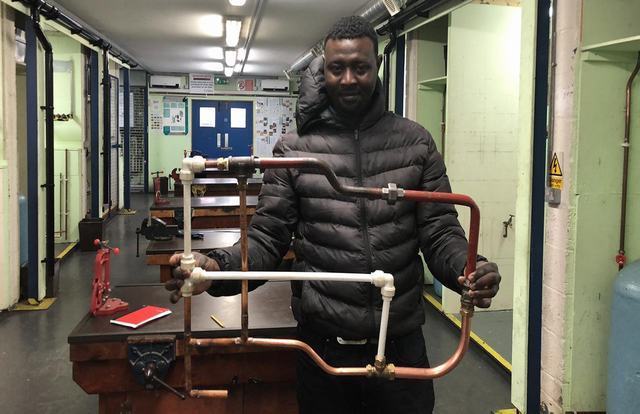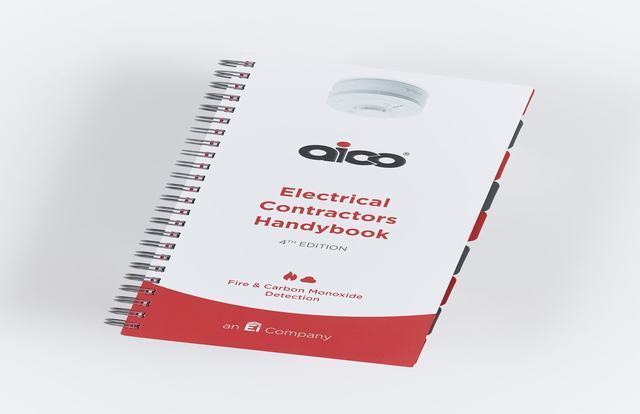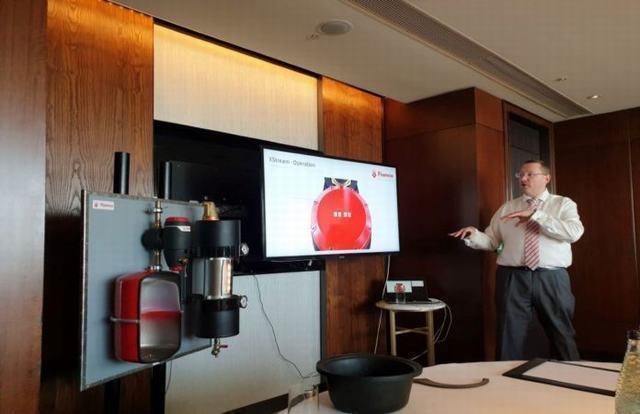February Newsletter 2020
February 2020 Newsletter
‘OFTEC embraces decarbonised heating solutions, Rexel smart home offer provides opportunity for installers, Survey finds smart thermostats are UK’s most wanted smart home product, Calls for all future homes to have insulated condensate pipes, Plans go in for HS2 Old Oak Station’.
Quick Links
OFTEC embraces decarbonised heating solutions
The government should embrace solutions to decarbonise heat in future homes focused on achieving set emission reduction targets rather than prescribing technologies, said OFTEC, responding to the Future Homes Standard consultation.
OFTEC’s submission underlined the importance of ensuring the decarbonisation policy is flexible to enable suitable solutions for a range of property building types and locations. Best value for consumers was also key and OFTEC says this will be best achieved by encouraging innovation and competition between technologies.
Paul Rose, chief executive officer of OFTEC, said: “We fully support the consultation’s ambition that properties built to the Future Homes Standard should produce 75-80% less emissions than current new builds. However, the consultation goes on to suggest that future homes will be fitted with heat pumps. OFTEC does not believe this blanket approach is the most effective way to achieve net zero. Alongside heat pumps and heat networks, hydrogen and liquid biofuels have an important role to play in decarbonising heat.
“Research shows liquid biofuels are particularly beneficial for new and existing homes in rural areas. Crucially, this practical, easy to implement solution provides consumers with an affordable option, achieving the highest carbon reduction impact for the lowest cost of all solutions currently available for off-grid homes.”
OFTEC’s consultation response also focuses on the importance of taking a ‘fabric first’ approach in new build properties to future-proof these homes.
He added: “Ensuring modern homes are built to minimise energy use, irrespective of the heating technology installed, should be the foundation for Part L proposals.
“Such a move will also help to reduce energy bills for consumers. It is essential that net zero solutions are fair to all property owners and we cannot build new homes that may cause additional fuel poverty.”

OFTEC embraces decarbonised heating solutions
Source: HPM Magazine
Domus Ventilation’s Eco-friendly MVHR takes a bow
Domus Ventilation – part of the Polypipe Group – recently had its HRXD Mechanical Ventilation with Heat Recovery (MVHR) systems installed into the Bow River Village development in East London.
Bow River Village is a new residential quarter south of the Queen Elizabeth Olympic Park in London. The village has been designed to reflect the architectural heritage of its immediate surroundings, with perpendicular, brick-built contemporary apartment buildings which pay homage to the nearby Victorian warehouses dotted along the river.
The apartments that make up the new development have been designed with modern and efficient living in mind, and are marketed with ‘eco-features to keep energy bills to the minimum’.
The Domus Ventilation MVHR units are a key eco-feature as they provide home owners with substantial savings on energy bills and improved indoor air quality. They work on the principle of extracting moisture-laden air from wet rooms whilst capturing up to 87% of the heat, which would otherwise be wasted, and using it to temper the filtered air which is simultaneously distributed around the home.
A total of 112 Domus Ventilation HRXD wall mounted MVHRs, along with Domus ducting and sound attenuators, have been installed during Phase 2 of the Bow River Village development.
The Domus Ventilation HRXD is a wall-mounted MVHR unit which intelligently matches ventilation rates to the internal environment and occupants’ requirements, for maximum homeowner comfort. This is achieved through advanced AMIE (Air Management for Indoor Environments) technology including features such as digital humidity control, automated summer bypass and accurate system balancing.
By accurately measuring air humidity, the HRXD’s extract speed automatically changes from background to boost as the level of humidity increases, thereby providing optimal ventilation performance. The thermal (summer) bypass feature operates in a similar manor, automatically activating when the air temperature reaches a pre-set level, allowing in cooler, fresh, filtered air, instead of distributing air which has been warmed from the waste energy extracted from the kitchen and wet rooms.
For the homeowner, a key benefit is that these features can be easily programmed based on time and temperature. This flexibility enables all comfort levels to be catered for.
At the heart of this intelligent air management is Domus Ventilation’s compact Bluebrain control, which also provides homeowners with helpful maintenance reminders for cleaning and replacing filters to ensure performance of the unit is maximised and air quality maintained.
When used with a kitchen and one wet room, at typical installation, the HRXD reportedly provides an 87% heat exchange performance and boasts a very low Specific Fan Power down to 0.66W/(l/s). It is also quiet, with background (normal) ventilation at 24dB(A) (typically whisper quiet). At Bow River Village, noise reduction has been enhanced through the use of Domus Silencers to provide improved sound attenuation and thermal insulation.
The HRXD has been designed to work most efficiently when used with Domus duct systems, as is the case at Bow River Village. Domus duct systems offer improved system performance through the exacting tolerances and engineered fit of the system, whereby pressure drops are minimised and air leakage virtually eliminated.

Domus Ventilation’s Eco friendly MVHR takes a bow
Source: Electrical Contracting News
New APHC workshops to offer insights into heat pumps and electrics
The Association of Plumbing and Heating Contractors (APHC) has teamed up with Travis Perkins to host a series of free workshops across England and Wales which are designed to update plumbing and heating engineers on a number of key industry developments.
In the Sales Trends and the Skills Gap for Alternative Heat Technologies sessions, Travis Perkins will be providing a valuable insight into how the market is developing from a regional perspective with regards to the sales of heat pumps and other alternative heat technologies as the industry develops to assist the country to meet its carbon neutral target.
For New Legal Requirements for Safe Electrical Isolation, the APHC will give an overview of what employers and sole traders need to do to comply with new legal requirements for Safe Electrical Isolation. Part of the legislation requires employers and sole traders to demonstrate they have the required knowledge to work compliantly with the incoming standards. To help assist with this, all attendees will receive a certificate to demonstrate they attended the APHC Safe Electrical Isolation Workshop.
Additionally, the APHC will be providing a technical overview on working compliantly with the Water Fittings Regulations and Byelaws and explain how installers can benefit from the WaterSafe Contractor Scheme which can be free to join.
John Thompson, Chief Executive at the APHC, explained: “By attending one of the free workshops, installers will learn how the heating market is already changing in terms of alternative heating technologies and how their knowledge and skills will have to develop to keep up with the industry. Plus, attendees will learn about new legal requirements for the safe isolation of electrical products which employers and sole traders need to be able to demonstrate they are compliant with”.
Readers can contact the APHC on 0121 711 5030 and marketing@aphc.co.uk for further information or to book a place.

New APHC workshops to offer insights into heat pumps and electrics
Source: HVP Magazine
Rexel smart home offer provides opportunity for installers
The new Smart Home offer from leading electrical distributor, Rexel, contains a sector-leading range of new and innovative products for installers to offer to its customers.
The demand for smart technology in the home is continuing to increase as homeowners seek greater control and want to reduce their spend on energy. Tech UK’s 2018 State of the Connected Home Report stated that, according to the International Energy Agency, by 2040, one billion households and 11 billion smart appliances could be in use worldwide.
To meet this demand, Rexel has joined forces with market leaders to develop its Smart Home offer which encompasses state-of-the-art smart solutions across security, heating, electrical, lighting and EV charging control.
Many items can be obtained immediately from any of Rexel’s 63 specialist Rexel Smart Home branches nationwide. The others are available via same or next day delivery with online ordering. Installers can also access expertise in branches to ensure they find the best solution for their customer.
Key new products include the Google smart control Nest Hub, which, with the built-in Google Assistant, brings users visual help at home. This voice-activated product displays the latest events, reminders and news from a single dashboard, all within an attractively designed digital photo frame.
Security is a key constituent of Smart Home, with a plethora of up-to-the-minute solutions on offer. The Yale Conexis L1 Smart Lock allows users to secure their home without a key. Bearing the British Standard Kitemark, it provides a range of access options, from in-app control and key cards to key tags and phone tags.

Rexel smart home offer provides opportunity for installers
Source: Electrical Contracting News
£1bn London Bankside Yards phase 2 approved
Native Land has got the planning green light for phase two of its £1bn Bankside Yards mixed-use development next to Blackfriars Bridge in London.
The Eastern Yards phase consists of five buildings ranging from seven to 34 storeys tall. These will deliver 550,000 sq ft of the 1.4m sq ft Bankside Yards site by the Thames.
The latest approval for the former site of Sampson House paves the way for 341 new homes, a 5-star, 126-bed hotel, together with office space.
Alasdair Nicholls, chief executive of Native Land, said: “This new planning consent will create a true mixed-use development which brings London together, with new east-west pedestrian routes, multiple transport links, a new village high street in the arches and new town square for Bankside, overlooking the river.”
The entire Bankside Yards project received planning consent in 2014 for homes, offices, restaurants, cultural uses and open space in a 5.5-acre riverside estate in central London, set around 14 historic railway arches.
Multiplex won the first phase at Bankside Yards, known as Western Yards, which started last year with McGee extending its demolition contract to the basement and concrete core for the initial 230,000 sq ft offices project, known as the Arbor.
This initial phase also includes a 240-home apartment building and 49,500 of independent retail, restaurant, cultural and amenity space in the restored railway arches.

£1bn London Bankside Yards phase 2 approved
Source: Construction Enquirer
Derwent advances zero carbon building target by 20 years
Developer Derwent London today announced it is bringing its net zero carbon building target forward by 20 years to 2030.
Paul Williams, chief executive, said that the developer’s future business vision would involve buying brown buildings and turning them green.
He said the fresh initiative would come with an extra financial cost, split between a mix of operational costs, extra capital expenditure as well as management time.
But he predicted more energy-efficient buildings would command higher rents and values in due course.
“Climate change presents an enormous challenge to us all, and our industry must respond.
“Derwent London has long recognised this; with regeneration at our heart, we have embedded sustainability into the organisation and are focussed on turning ‘brown’ buildings ‘green’,” said Williams
“Today we are taking our ambition to the next level bringing our net zero carbon target forward by twenty years to 2030, aligned with COP21’s 1.5°C climate scenario.”
Derwent London’s three projects currently in construction will be net zero carbon buildings.
On completion, they will be operated using renewable energy and carbon produced in the development process will be offset.

Derwent advances zero carbon building target by 20 years
Source: Construction Enquirer
Eye-catching Newcastle office plan
Plans have been unveiled to build a striking new office scheme on Newcastle’s East Quayside.
Internation architect Bjarke Ingels Group has designed the office project on a hairpin-shaped footprint to negotiate the steeply sloping site.
The building height will wind down from 12 storeys to street level by way of a linear roof-top garden.
The No. 1 Quayside project, which will offer just over 100,000 sq ft of office space, will be built on a disused City Road site.
It is the architect’s first project outside of London and is being brought forward by local landowner Rob Cameron.
He said: “This is a landmark site and, as such, commands a landmark building. Something iconic, with real architectural merit.
“We’ve had really positive pre-application discussions with Newcastle City Council and I’m excited to progress the project to fruition.”
Bjarke Ingels, founder and creative director of BIG, said: “Our proposal is born from the unique conditions of Newcastle’s architectural elements, the sloping hills and the curvy frames of the bridges over the Tyne.
“The ascending serpentine silhouette feels like a fresh yet familiar continuation of this unique urban landscape.”

Eye-catching Newcastle office plan
Source: Construction Enquirer
Survey finds smart thermostats are UK’s most wanted smart home product
A recent survey has found that smart thermostats are the smart home product Brits most want to own in 2020.
Sellhousefast.uk surveyed 1,462 UK households to discover the smart home products they planned to purchase this year.
The company found that a smart thermostat is the smart home product of choice for 71% of respondents. Thereafter, 66% want to fit a smart doorbell in 2020.
It also seems home security is a high priority for homeowners this year, with 60% expressing a strong desire to install smart cameras around their property, while 57% aim to have smart locks.
At the other end, a smart oven/hob is the smart home product Brits least intend to buy, with only 17% wanting the appliance in their kitchen this year.
Additionally, Sellhousefast.uk sought to find out the methods households would use to get advice/recommendations on smart home products.
From this, Sellhousefast.uk found that Brits are most likely to use an online search engine (48%) like Google to get more information on a smart home device/appliance they are interested in.
Subsequently, 43% would opt to directly contact a smart home technology manufacturer. Moreover, 39% feel their family/friends will give them good advice/recommendations on smart home products.
Robby Du Toit, Managing Director at Sellhousefast.uk, commented: “The rise of smart home technology over the last few years has been nothing short of extraordinary. With multiple smart home devices/appliances now available on the market, there is now greater choice than ever before.
“As Brits awareness and understanding of different smart home products gradually improves, the overall adoption rate for the technology will only increase. Especially if the products continue to be innovative and make everyday home tasks/responsibilities quicker as well as easier.”

Survey finds smart thermostats are UK’s most wanted smart home product
Source: HVP Magazine
New electrical safety guide launched to help duty holders reduce workplace risks
With 1,000 workplace accidents associated with electric shocks and burns reported each year1, Bureau Veritas, has unveiled its new Electrical Safety Guide, designed to support duty holders in understanding how to reduce risks within its organisation.
Reflecting the health and safety expert’s continued commitment to educating businesses on the importance of compliance and best practice in electrical installations, the guide has been designed to support duty holders in growing their understanding of electrical responsibilities and fill any gaps in knowledge.
With a sleek design and clear format, the guide sets out a best practice concept for a compliance strategy, including the business’ recommended ‘safe system of work’. This is a combination of systems, processes and procedures designed so that a defined work activity can be done without undue risk to health or safety, including but not limited to risk assessments and method statements, control measures, and permits and supervision. The guide also defines the competency requirements of a person carrying out works on electrics, and the importance of regularly testing and inspecting an installation, to ensure compliance to the BS 7671 and EAWR regulations.
The Electricity at Work Regulations 1989 (EAWR) – part of the Health and Safety at Work Act – places statutory obligations on duty holders to ensure the safety of electrical installations. EAWR applies to all operational voltages, and electrical systems and equipment, assisting duty holders to achieve electrical safety, take precautions against risk of death and personal injury and comply with the duties imposed.
Michael Kenyon, Technical Manager at Bureau Veritas, said: “More than ever, businesses are facing increased pressure to drive efficiencies within electrical installations, whilst simultaneously achieving compliance and meeting best practice standards, in order to prevent injury or death, reduce the risk of damage to buildings, and trying to reduce costs too. And the statistics speak for themselves, with more than half of all fires in the UK caused by electricity in 2015/161, and 25 workplace fatalities since 2014 from contact with electricity or electrical discharge1.
“However, while electrical safety is no doubt at the top of the agenda for many duty holders, a sizeable proportion may not fully understand what their role and responsibilities truly entail. Knowledge is power and taking full advantage of our electrical safety guide will ensure duty holders have the correct information to hand, and will hopefully be able to successfully mitigate any risks regarding electricity in the workplace, and undoubtedly, will help to save lives.”
This latest launch follows on from the recent electrical safety awareness course, led by the Bureau Veritas Learning Academy, which taught senior business leaders about the important aspects of the law around electrical safety including recent changes to BS 7671 – IET Wiring Regulations, with guidance on how to apply this within a workplace environment and create an effective electrical compliance strategy.
Michael Kenyon, continues: “There is no one-size-fits-all solution to compliance regarding electrical safety. Ultimately, an organisation must be confident that it has taken all reasonable steps and exercised all due diligence to ensure compliance. Key to this is a reasonable, realistic and achievable compliance strategy, which our technical specialists at Bureau Veritas can support on.”
Whatever the level of in-house expertise, Bureau Veritas offers a comprehensive package of electrical services to suit all requirements. From external audit services to fully bespoke electrical management schemes, it offers clients the unique opportunity to select the services they require for electrical testing and inspection, whilst benefitting from the cost-efficiencies of a combined service.

New electrical safety guide launched to help duty holders reduce workplace risks
Source: Electrical Times
Calls for all future homes to have insulated condensate pipes
Condensate Pro has called for all builds to have condensate pipes insulated as standard.
The company has commented following a recent consultation from the Department for Business, Enterprise and Industrial Strategy (BEIS) setting out the UK Government’s plans for the Future Homes Standard.
This included a proposal to include more stringent build quality advice on pipework where it enter or exits a building.
Dave Smith, managing director of Condensate Pro, said: “We welcome the fact that new build quality guidance is potentially being included in the Building Regulations, which will help energy efficiency. However, you must not ignore the pipework itself. If the condensate pipe connected to condensing boilers, or the pipes running to Air Source Heat Pumps are not fully protected properly, including those systems which are powered by gas/ oil or even in the future, hydrogen boilers, they may be at risk of breakdown or not running efficiently.
“Boiler breakdown due to frozen pipework is usually at a time when the heating is really needed and a professional installer may not be able to get to a home due to the weather conditions. We would like to see external condensate and heating pipes running to and from heat pumps insulated properly and this practice added to the Build Quality guidance outlined in Annex C of the consultation and also bring British Standards up to date.
“Our hope is that the focus in the new building regulations on energy efficiency and pipework coming into the home, encourages the industry to look again at best practice, even in retrofit situations on existing houses. We believe the current industry guidance is slightly flawed as it is very difficult to achieve practically on site – mainly in terms of pipe size and holes drilled into cavity walls where the pipe passes through. I would like the guidance to be changed, but in the meantime Condensate Pro provides a much simpler, better looking and easy way to make sure pipes are protected.”
Condensate Pro fits any condensate pipe installation, with specially designed UV/water resistant lagging, bond and seal adhesive.

Calls for all future homes to have insulated condensate pipes
Source: HPM Magazine
UK utilities sector quadruples investments in EU since Brexit vote
The UK utilities sector has quadrupled its investments in the EU since the Brexit vote, while earnings have increased just a quarter, analysis of the latest ONS data has revealed.
“UK utilities firms haven’t shied away from investments in the EU, and now they will be hoping that earnings catch up.
“That would be good news for British industry as the country starts to set its own course on the journey to become a new outward-looking nation outside the EU.”

UK utilities sector quadruples investments in EU since brexit vote
Source: Electrical Review
Sisk wins £21.5m deal to upgrade Leeds Corn Exchange area
John Sisk & Son has been confirmed as main contractor on a £21.5m scheme to improve the Corn Exchange area in Leeds.
Leeds City Council has now approved the scheme which is part of the £270m Connecting Leeds programme.
Sisk will start in June to transform Call Lane, New Market Street, Kirkgate, Lower Briggate Duncan Street and parts of Vicar Lane and Boar Lane.
Work will include widening pavements, introducing more greenery and improved public realm.
The scheme will also offer priority for pedestrians and cyclists in a bid to encourage a modal shift from private cars to walking, cycling and public transport use.
The expected completion date for all of the work is by winter 2021.
Leeds City Council’s executive member for climate change, transport and sustainable development, Councillor Lisa Mulherin, said: “The enhancements will place the iconic buildings of the Corn Exchange and Kirkgate Market in a more appropriate setting.
“The bus priority measures and improved walking and cycling routes will improve connectivity services and air quality in the city.
“Like all major schemes, there will be disruption, however Leeds City Council will work closely with the bus companies, other transport providers and business to keep this to a minimum and will work hard to keep the public informed of changes which affect them.”

Sisk wins £21.5m deal to upgrade Leeds Corn Exchange area
Source: Construction Enquirer
Millwall FC reveal new stadium plan
Millwall FC are preparing plans to expand the Den stadium in South London to 34,000 seats.
The proposals under development will see a phased expansion of the existing stadium, built as additional upper tiers behind the existing seating bowl.
The plans, drawn up by AFL Architects, include a new public plaza at the heart of New Bermondsey, which is elevated over parking and service areas and will accommodate retail, commercial and community use spaces along the street frontages.
Complementing all of this will be flexible commercial space for events and conferencing, alongside residential developments.
Before submitting for planning, the Club needs to reach an agreement with the land-owning local borough council on a new lease for The Den and surrounding land.
The development strategy is to retain as much of the existing stadium structure as possible while providing for a flexible phased uplift to both facilities and capacity over time.
This maintains the stadium in use for fans, and minimises demolition and construction waste.
Steve Kavanagh, Millwall’s Chief Executive, said: “It has been a long and at times difficult journey to this point, but we are delighted with progress now. As long as we can secure an appropriate new lease, we can play our part in the growth and development of Millwall Football Club and its community.

Millwall FC reveal new stadium plan
Source: Construction Enquirer
Plans go in for HS2 Old Oak Station
HS2 has revealed fresh designs for its west London super-hub at Old Oak Common after formally submitting it for planning approval.
Work at Old Oak Common to prepare for construction of the station has been ongoing since 2017 and the site is nearly ready to be handed over to HS2’s station construction partner at Old Oak Common, Balfour Beatty Vinci Systra JV.
HS2’s enabling works contractor, Costain Skanska JV has cleared 32,000 cubic meters of former rail depot sheds and outbuildings, working through 105,000 cubic meters of earth to clear the site and remove any contamination built up over a century of continuous railway use.
Engineering consultant WSP, and architects WilkinsonEyre have led the design for the station with six high-speed platforms situated underground.
These will connect to the adjoining conventional station at ground level via a shared overbridge. This has eight conventional train platforms, to be served by the Elizabeth Line, taking passengers to Heathrow and Central London, and trains to Wales and the West of England.
A light and airy concourse will link both halves of the station, unified by a vast roof inspired by the site’s industrial heritage.
To the west of the station, above the HS2 platforms, there will be a new public park to greet visitors to Old Oak Common.
The submission also includes an application to lower and widen Old Oak Common Lane, which will improve access to the station for buses and pedestrians.
The planning application will now be considered by OPDC and a decision is expected this summer.

Plans go in for HS2 Old Oak Station
Source: Construction Enquirer



























































